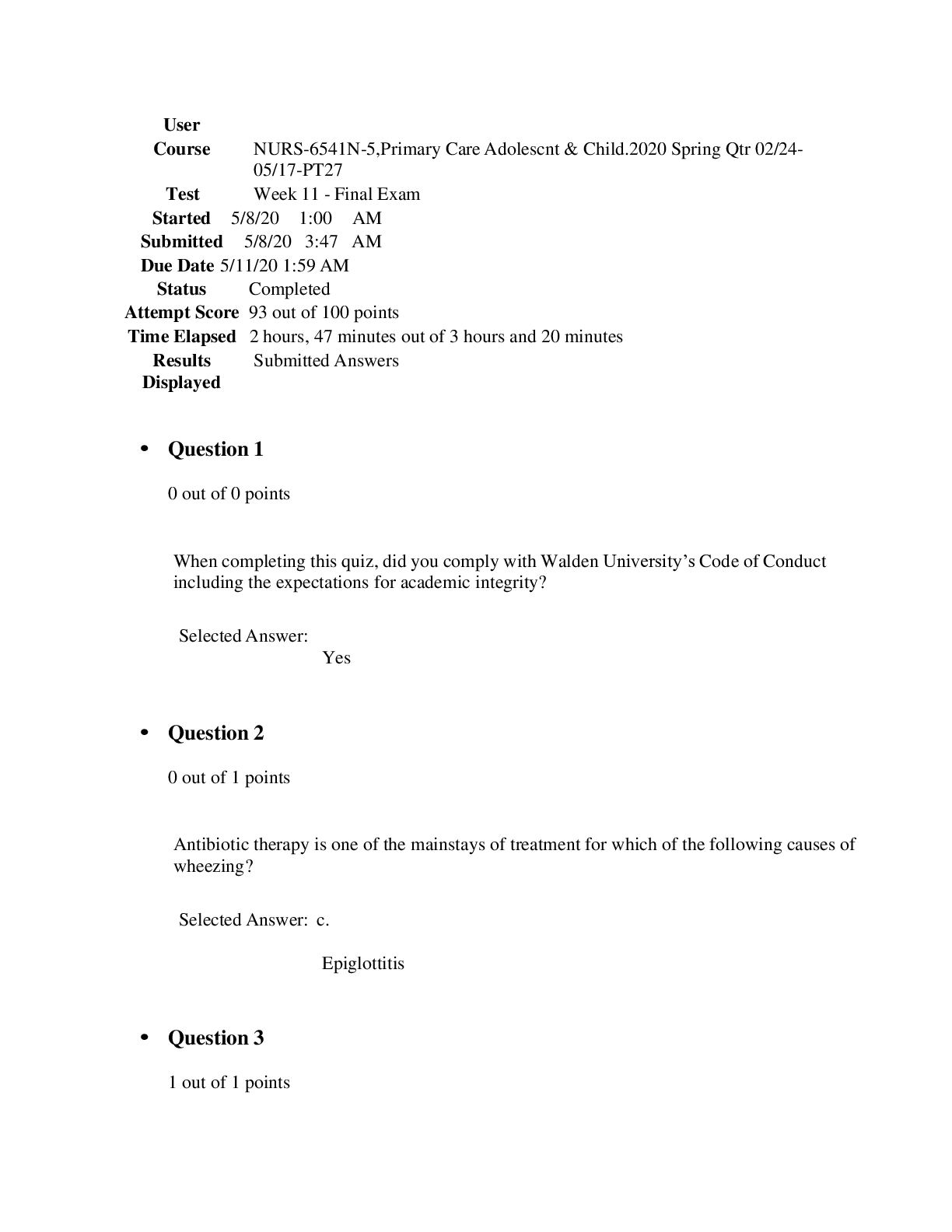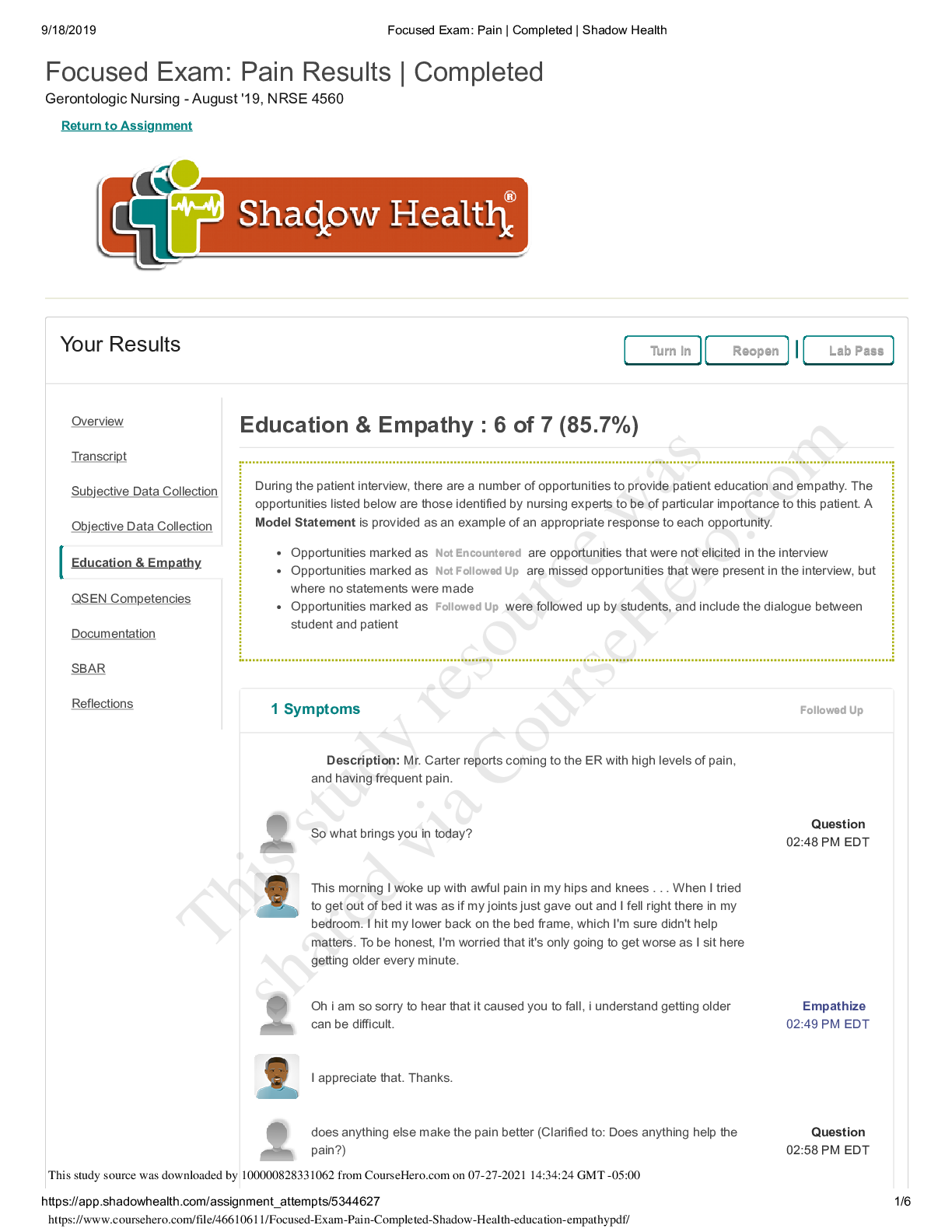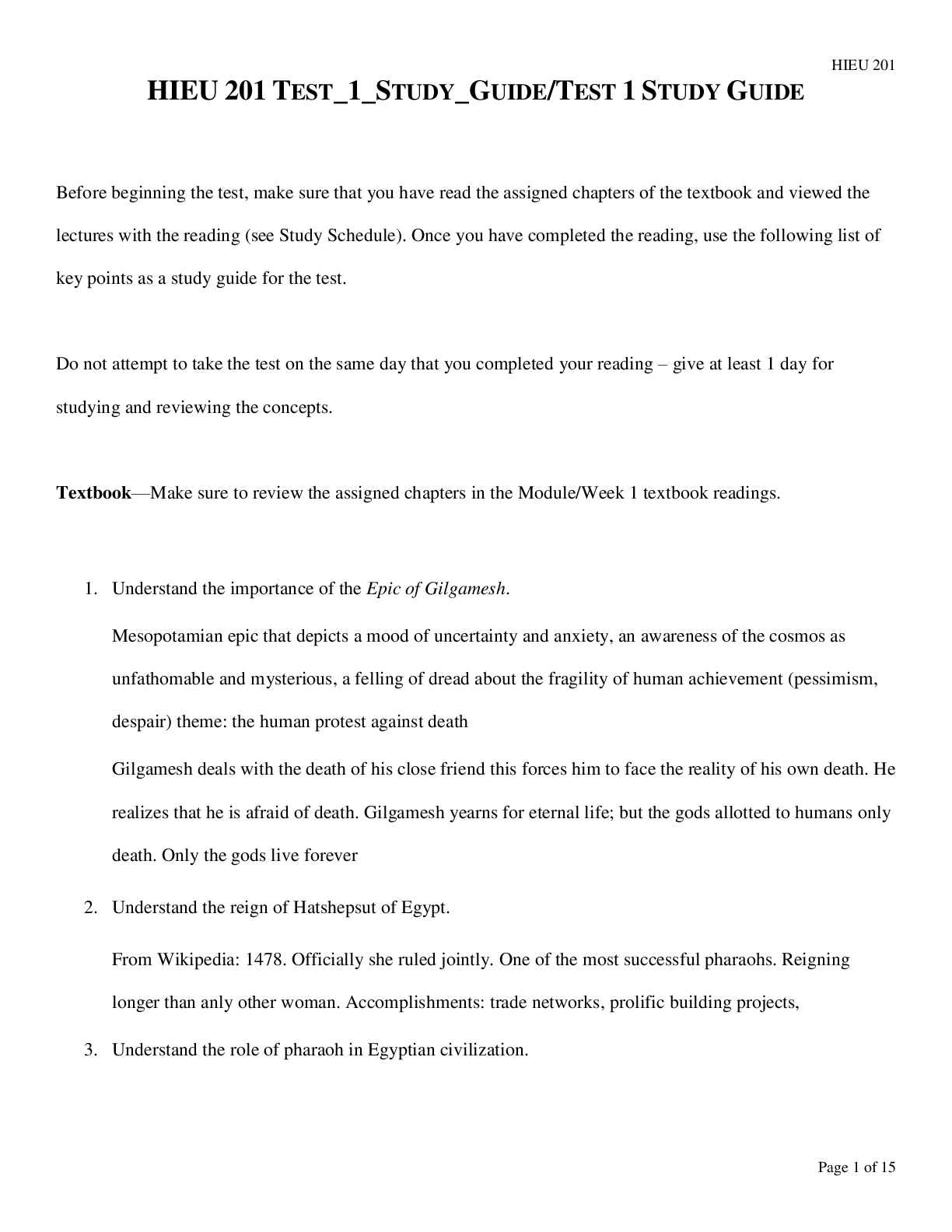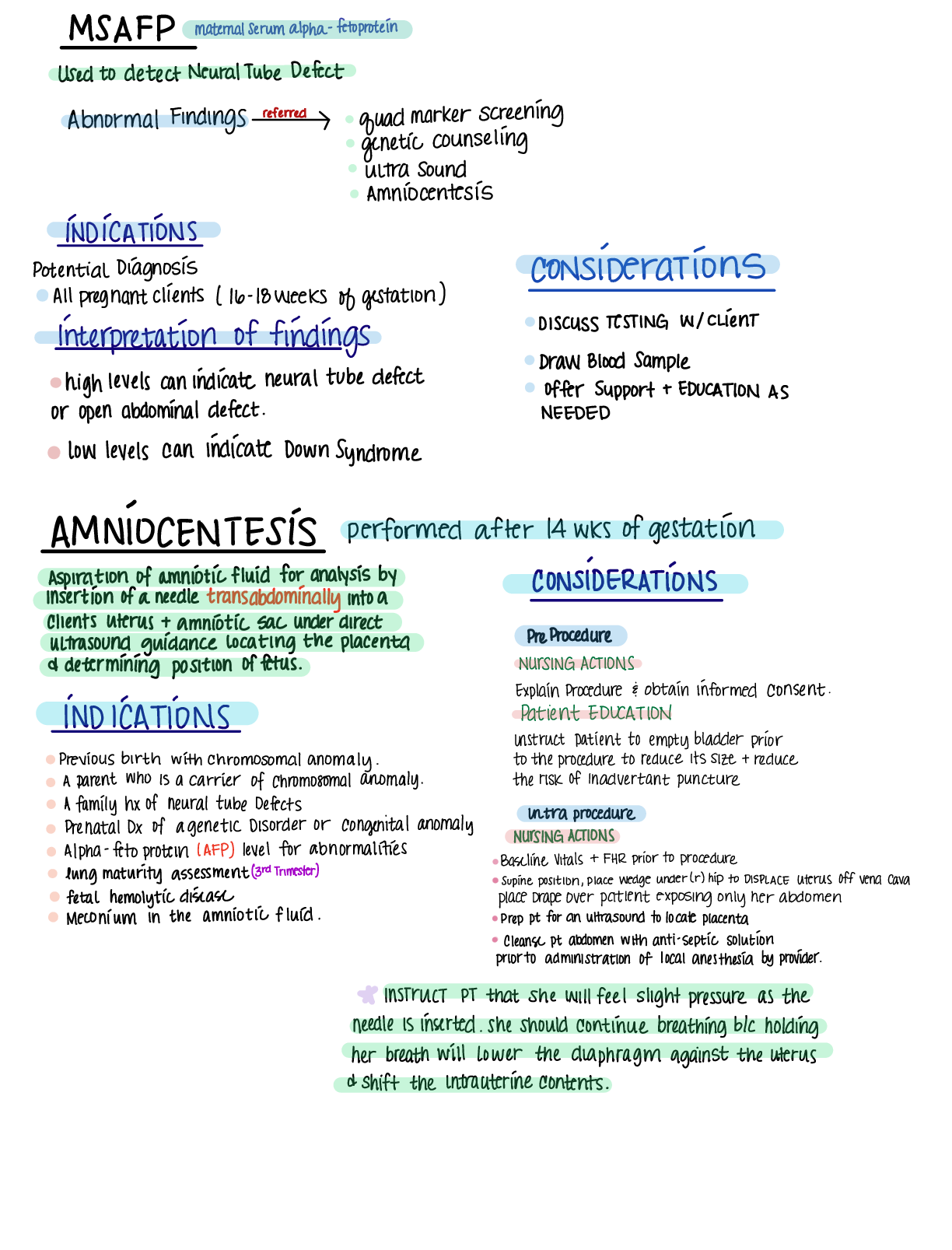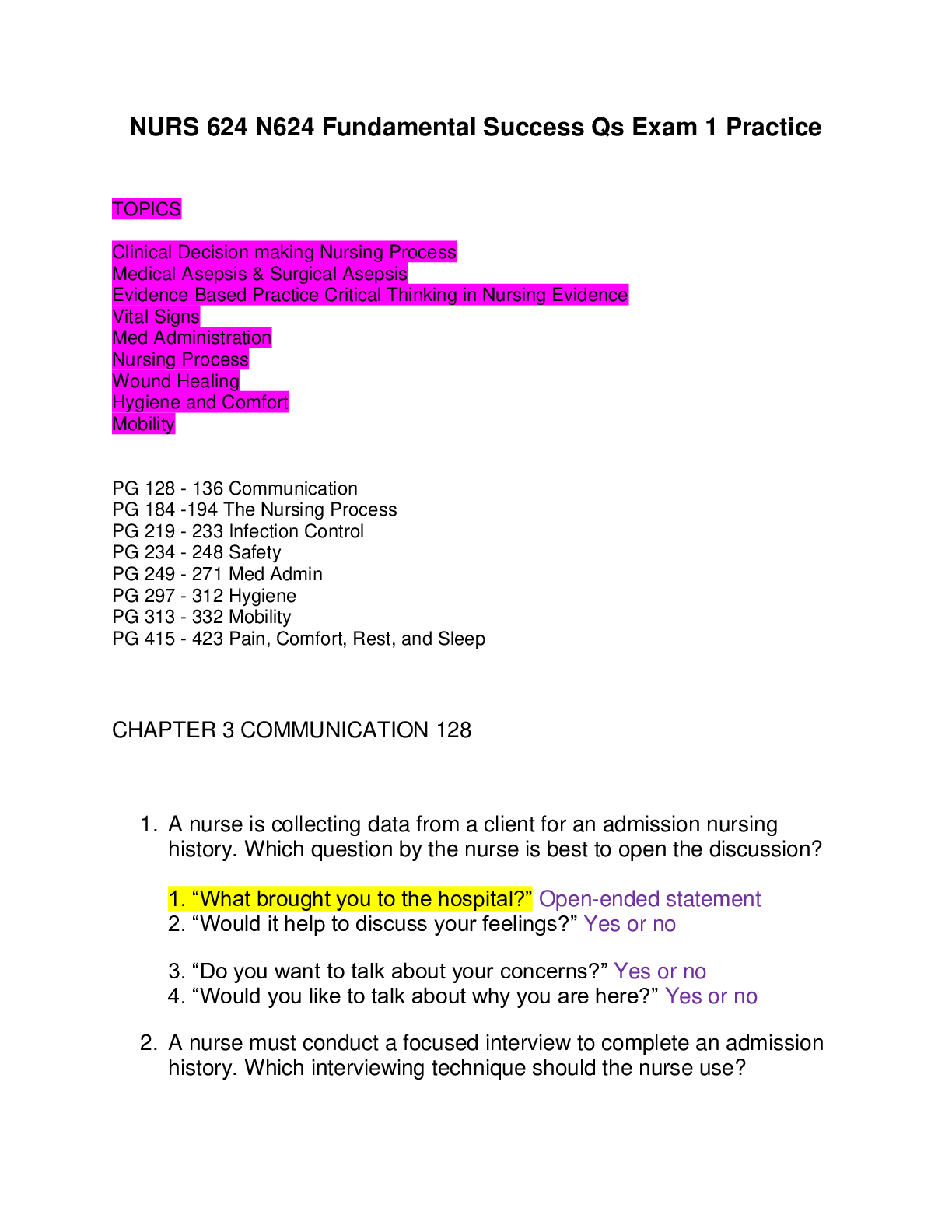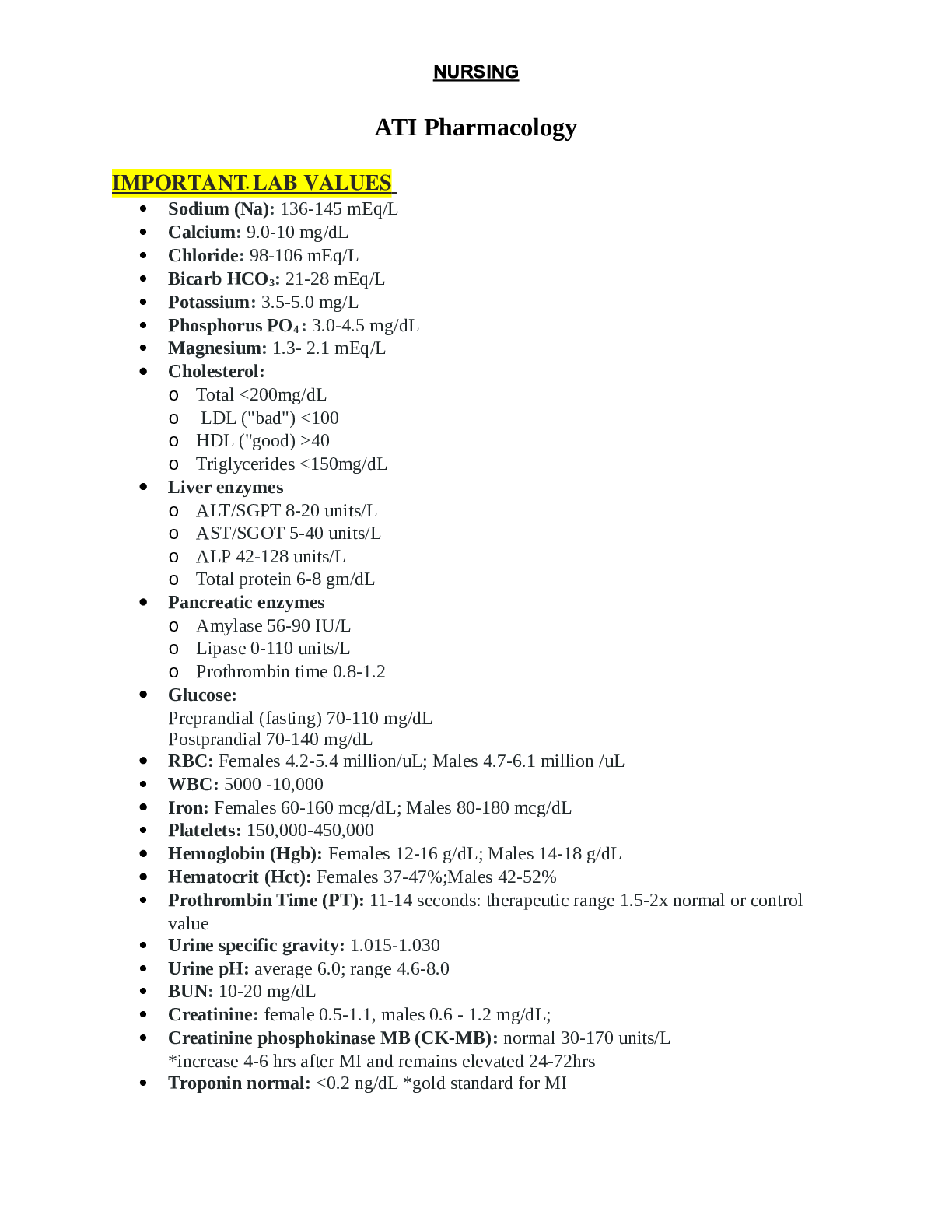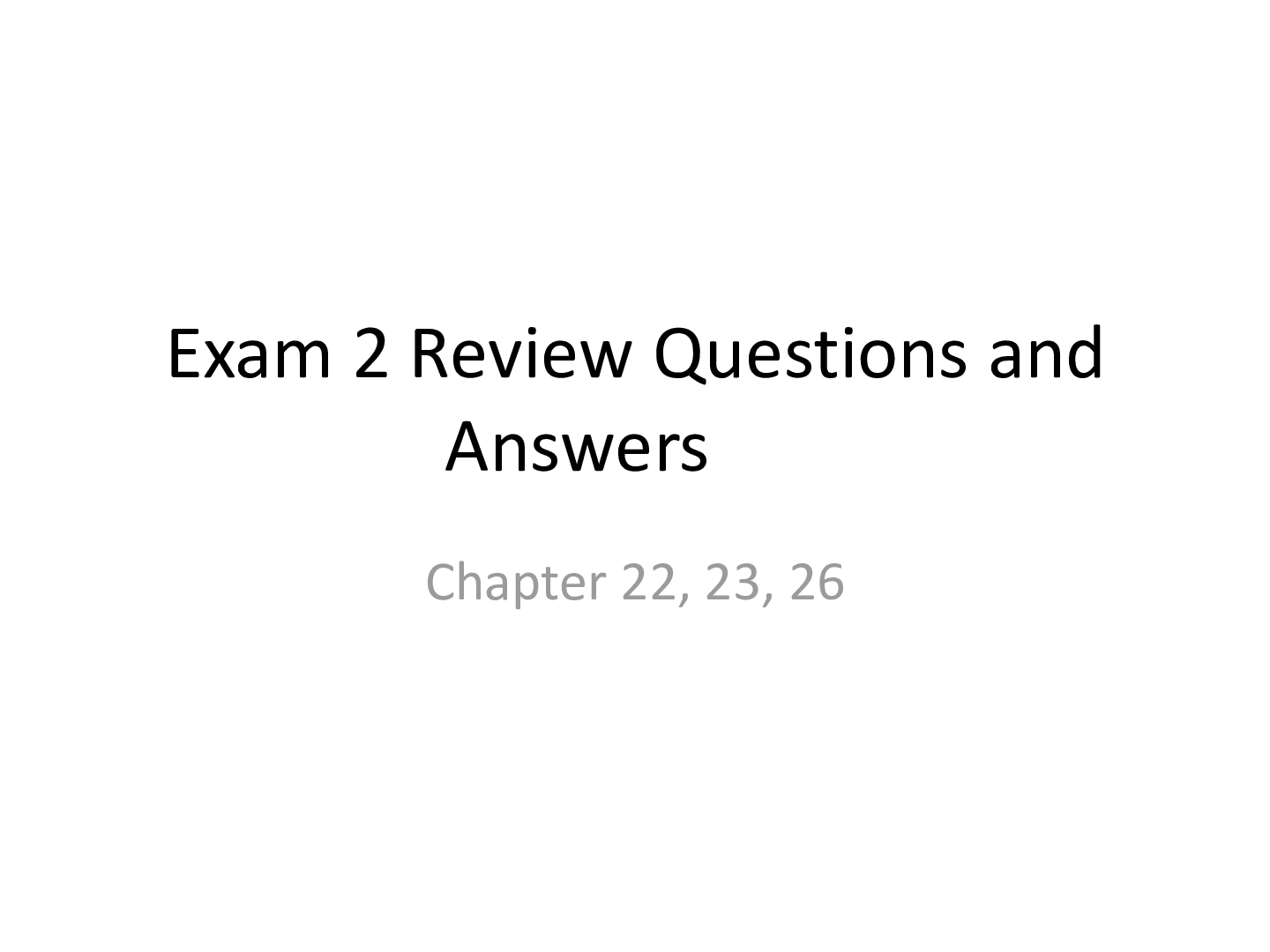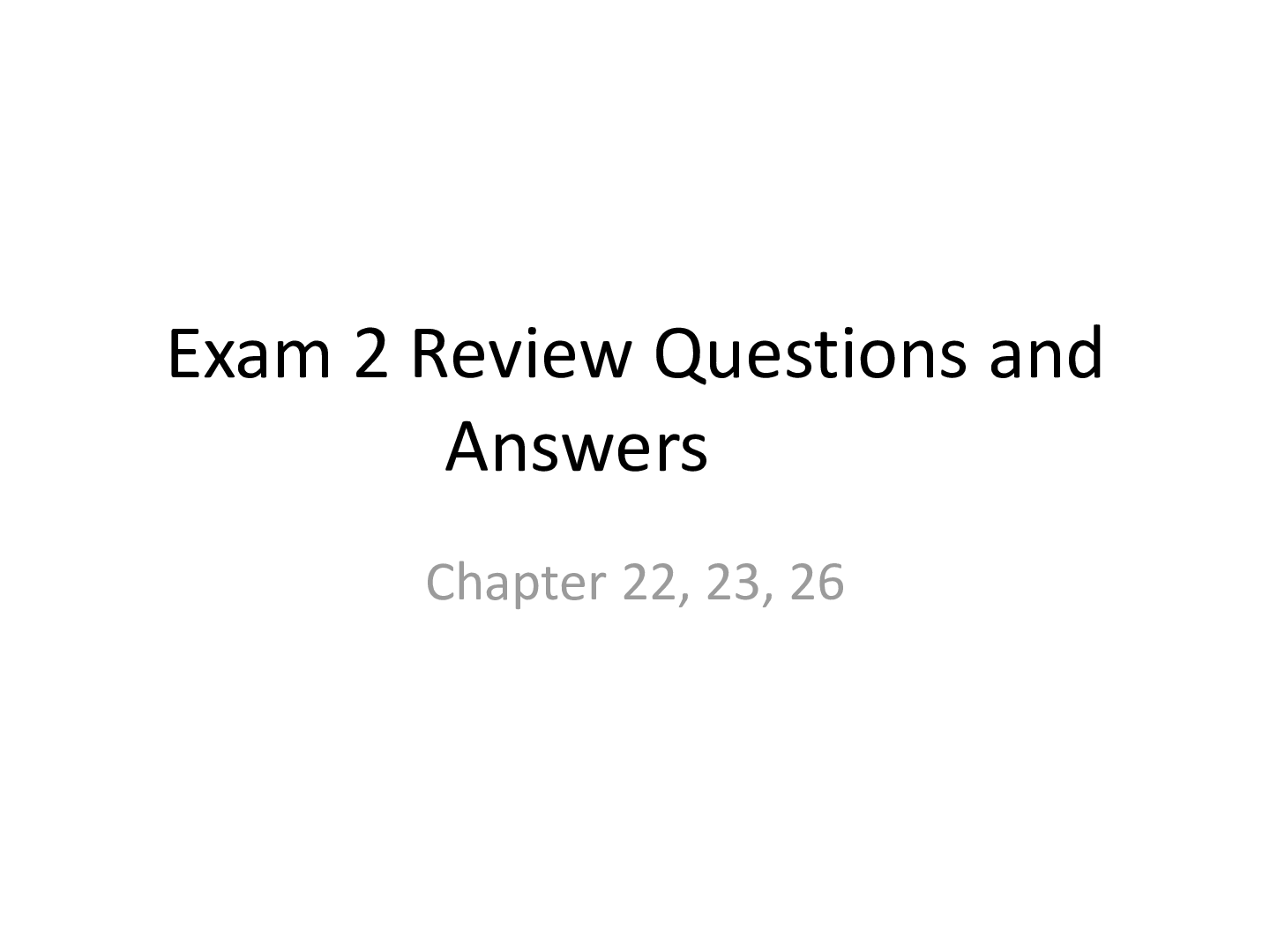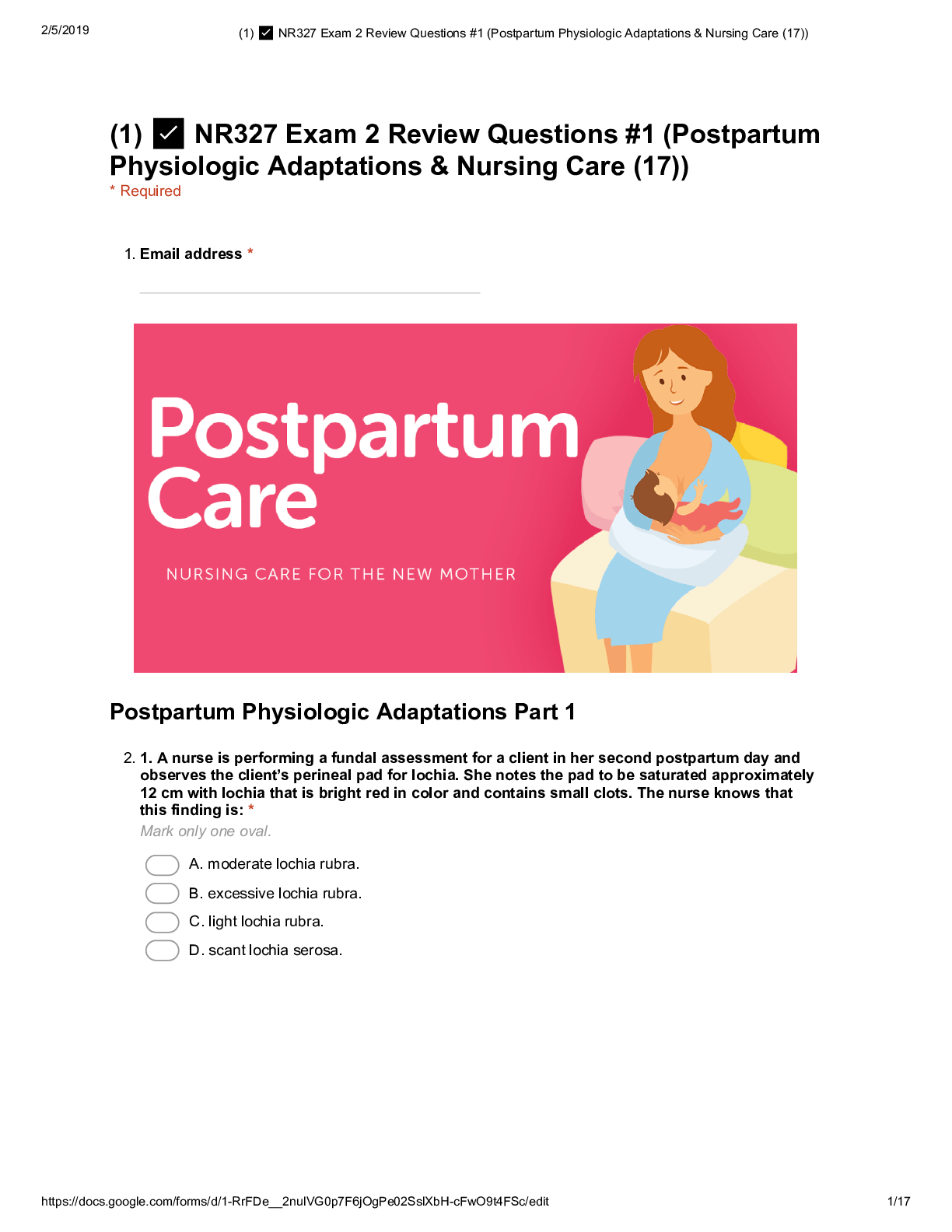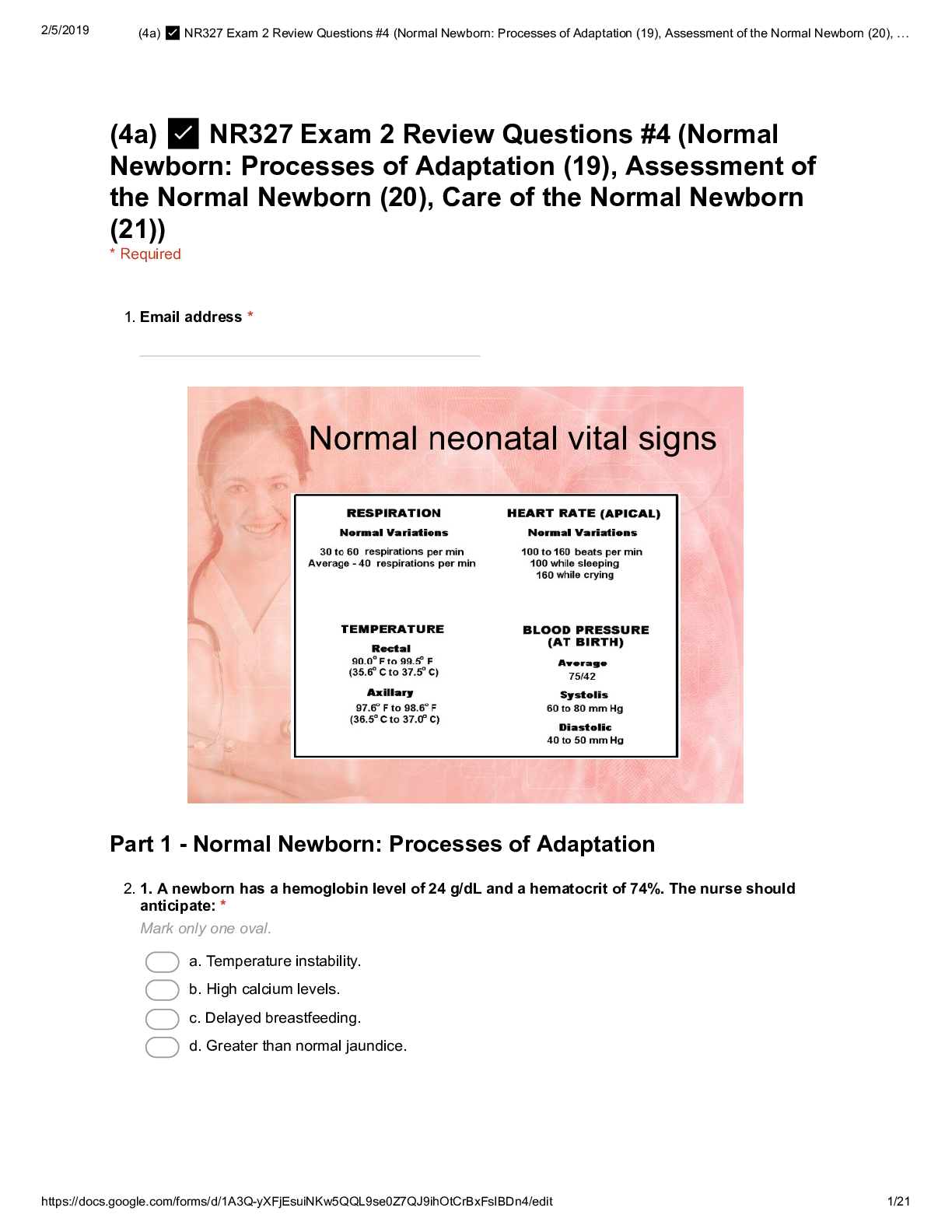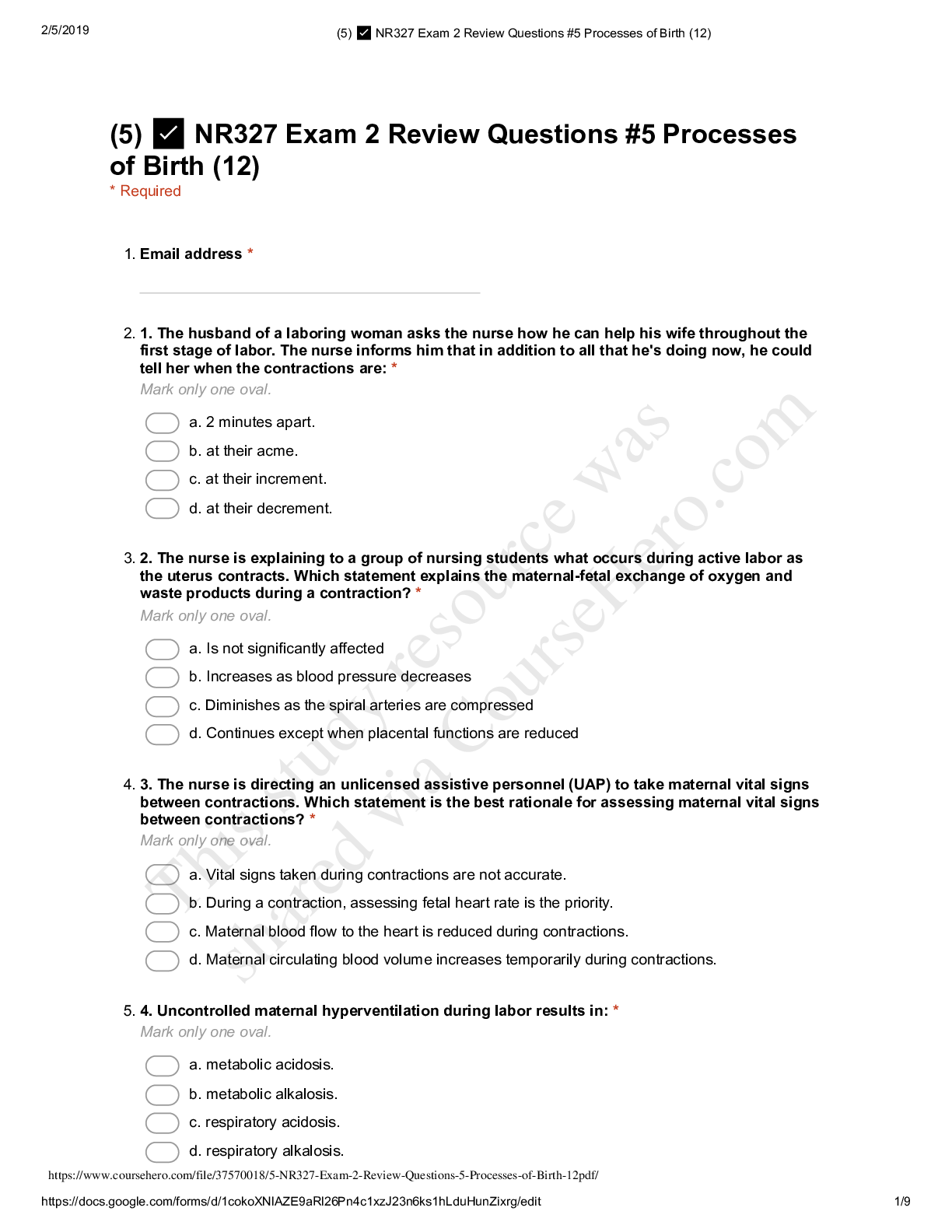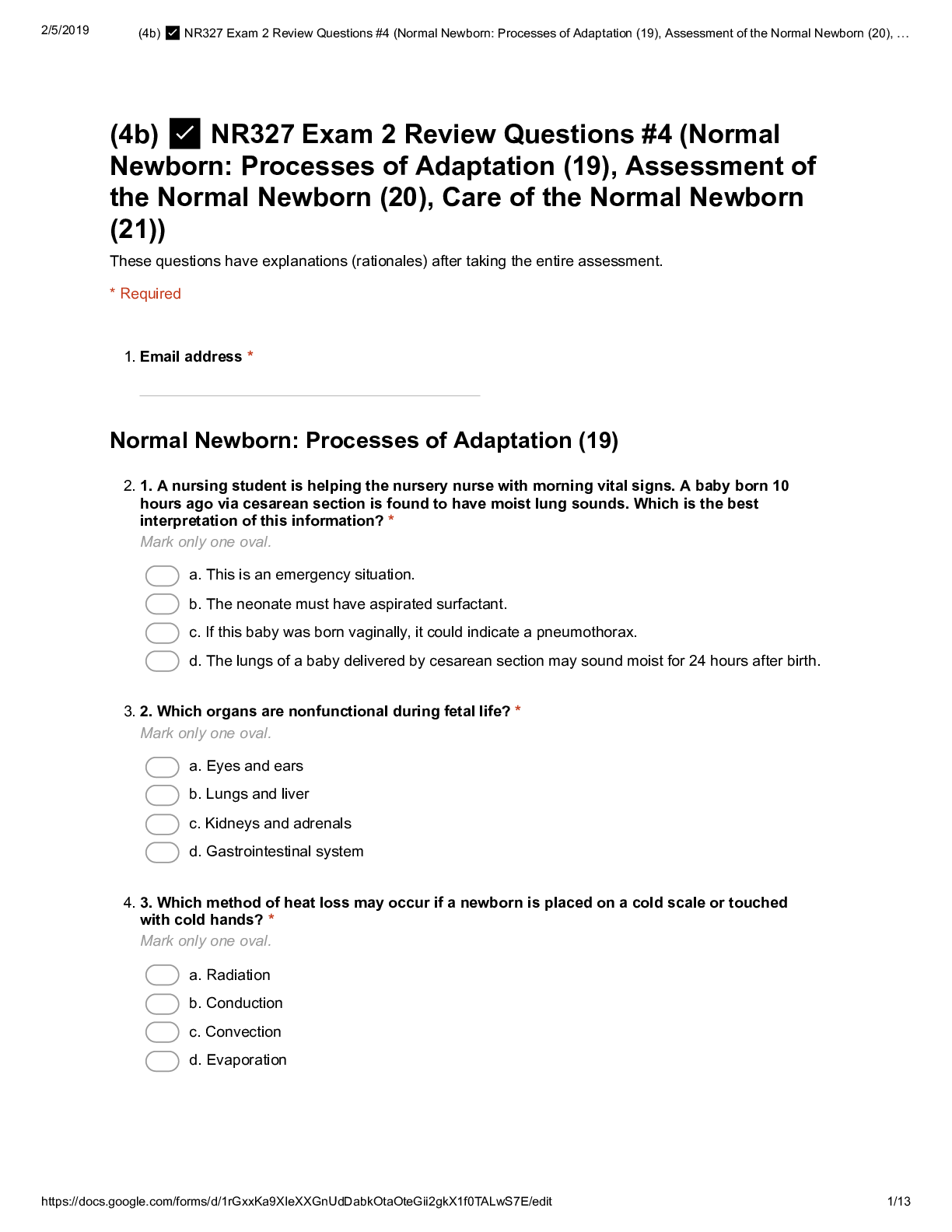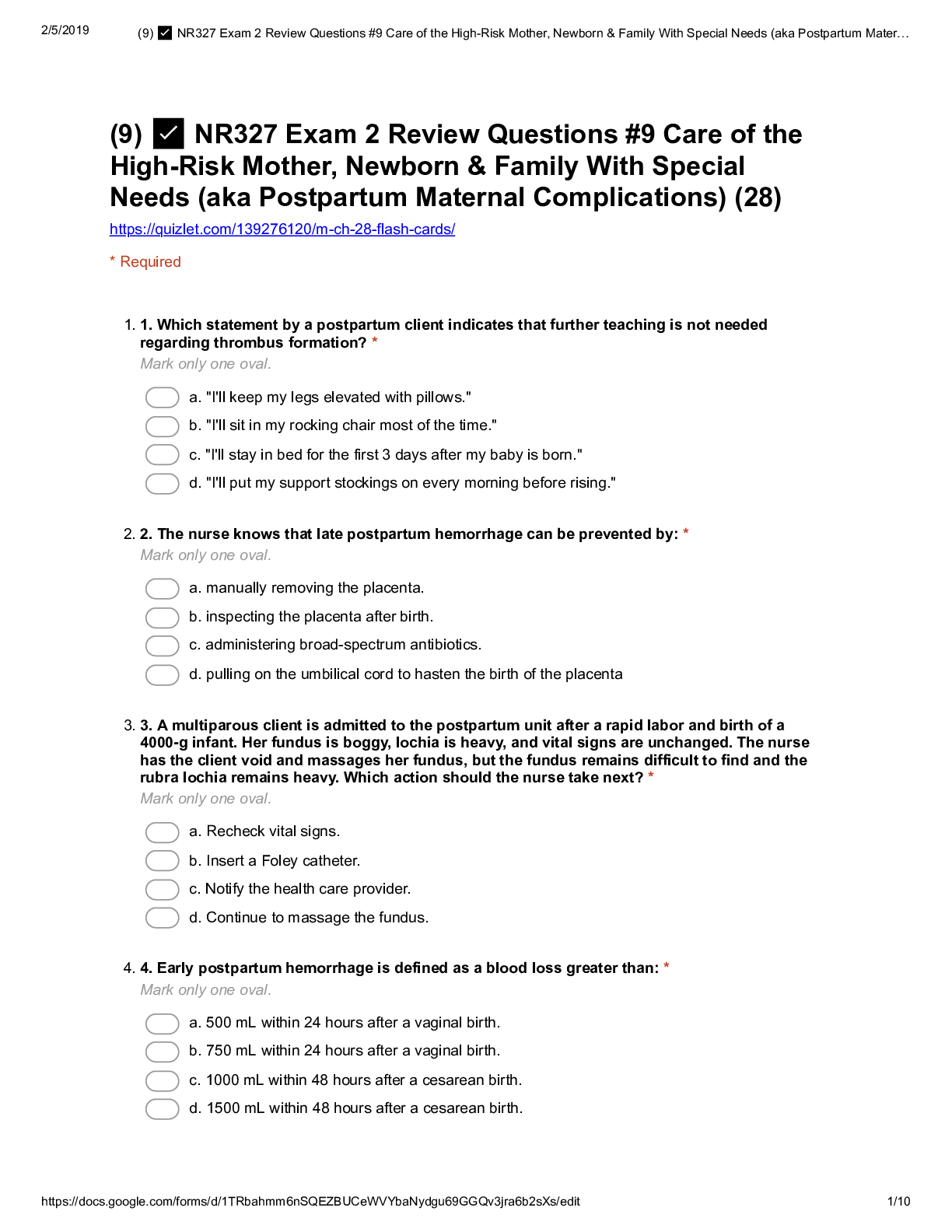*NURSING > STUDY GUIDE > NR327 Exam 2 Review Questions #1b (Postpartum Physiologic Adaptations & Nursing Care (All)
NR327 Exam 2 Review Questions #1b (Postpartum Physiologic Adaptations & Nursing Care
Document Content and Description Below
2/5/2019 (1b) ✅ NR327 Exam 2 Review Questions #1b (Postpartum Physiologic Adaptations & Nursing Care (17)) https://docs.google.com/forms/d/16KSMBWekrgGRvsy1m5XNHeHs9CcBr5226MgITYLecHU/edit 1/8 (1b... ) ✅ NR327 Exam 2 Review Questions #1b (Postpartum Physiologic Adaptations & Nursing Care (17)) * Required 1. Email address * 2. 1. A postpartum client overhears the nurse tell the health care provider that she has a positive Homans sign and asks what it means. Which is the nurse's best response? * Mark only one oval. a. "You have pitting edema in your ankles." b. "You have deep tendon reflexes rated 2+." c. "You have calf pain when the nurse flexes your foot." d. "You have a 'fleshy' odor to your vaginal drainage." 3. 2. Which client would be most likely to have severe afterbirth pains and request a narcotic analgesic? * Mark only one oval. a. Gravida 5, para 5 b. Primipara who delivered a 7-lb boy c. Client who is bottle feeding her first child d. Client who wishes to breastfeed as soon as her baby is out of the neonatal intensive care unit 4. 3. Which maternal event is abnormal in the early postpartal period? * Mark only one oval. a. Diuresis and diaphoresis b. Flatulence and constipation c. Extreme hunger and thirst d. Lochial color changes from rubra to alba 5. 4. Which fundal assessment finding at 12 hours after birth requires further assessment? * Mark only one oval. a. The fundus is palpable at the level of the umbilicus. b. The fundus is palpable two fingerbreadths above the umbilicus. c. The fundus is palpable one fingerbreadth below the umbilicus. d. The fundus is palpable two fingerbreadths below the umbilicus. https://www.coursehero.com/file/37570022/1b-NR327-Exam-2-Review-Questions-1b-Postpartum-Physiologic-Adaptations-Nursing-Care-17pd/ This study resource was shared via CourseHero.com2/5/2019 (1b) ✅ NR327 Exam 2 Review Questions #1b (Postpartum Physiologic Adaptations & Nursing Care (17)) https://docs.google.com/forms/d/16KSMBWekrgGRvsy1m5XNHeHs9CcBr5226MgITYLecHU/edit 2/8 6. 5. If the client's white blood cell (WBC) count is 25,000/mm3 on her second postpartum day, which action should the nurse take? * Mark only one oval. a. Document the finding. b. Tell the health care provider. c. Begin antibiotic therapy immediately. d. Have the laboratory draw blood for reanalysis. 7. 6. Postpartal overdistention of the bladder and urinary retention can lead to which complication? * Mark only one oval. a. Fever and increased blood pressure b. Postpartum hemorrhage and eclampsia c. Urinary tract infection and uterine rupture d. Postpartum hemorrhage and urinary tract infection 8. 7. A postpartum client asks, "Will these stretch marks go away?" Which is the nurse's best response? * Mark only one oval. a. "No, never." b. "Yes, eventually." c. "They will fade to silvery lines but won't disappear completely." d. "They will continue to fade and should be gone by your 6-week checkup." 9. 8. A pregnant client asks when the dark line on her abdomen (linea nigra) will go away. The nurse knows the pigmentation will decrease after birth because of: * Mark only one oval. a. increased estrogen. b. increased progesterone. c. decreased human placental lactogen. d. decreased melanocyte-stimulating hormone. 10. 9. If the fundus is palpated on the right side of the abdomen above the expected level, the nurse should suspect that the client has which? * Mark only one oval. a. Distended bladder b. Normal involution c. Been lying on her right side too long d. Stretched ligaments that are unable to support the uterus https://www.coursehero.com/file/37570022/1b-NR327-Exam-2-Review-Questions-1b-Postpartum-Physiologic-Adaptations-Nursing-Care-17pd/ This study resource was shared via CourseHero.com2/5/2019 (1b) ✅ NR327 Exam 2 Review Questions #1b (Postpartum Physiologic Adaptations & Nursing Care (17)) https://docs.google.com/forms/d/16KSMBWekrgGRvsy1m5XNHeHs9CcBr5226MgITYLecHU/edit 3/8 11. 10. The Centers for Disease Control and Prevention (CDC) recommends the use of which personal protective equipment with which the nurse is likely to come into contact? * Mark only one oval. a. Any body fluids b. Any client at any time c. Blood and blood products d. Any client suspected of being HIV-positive 12. 11. Rho(D) immune globulin will be ordered postpartum if which situation occurs? * Mark only one oval. a. Mother Rh-negative, baby Rh-positive b. Mother Rh-negative, baby Rh-negative c. Mother Rh-positive, baby Rh-positive d. Mother Rh-positive, baby Rh-negative 13. 12. If rubella vaccine is indicated for a postpartum client, which instructions to the client should be included? * Mark only one oval. a. No specific instructions b. Drinking plenty of fluids to prevent fever c. Recommendation to stop breastfeeding for 24 hours after the injection d. Explanation of the risks of becoming pregnant within 28 days following injection 14. 13. Which is the best measure to prevent abdominal distention following a cesarean birth? * Mark only one oval. a. Rectal suppositories b. Carbonated beverages c. Early and frequent ambulation d. Tightening and relaxing abdominal muscles 15. 14. Which documentation in the client's chart on the 14th postpartum day indicates a normal involution process? * Mark only one oval. a. Breasts firm and tender b. Episiotomy slightly red and puffy c. Moderate bright red lochial flow d. Fundus below the symphysis and not palpable https://www.coursehero.com/file/37570022/1b-NR327-Exam-2-Review-Questions-1b-Postpartum-Physiologic-Adaptations-Nursing-Care-17pd/ This study resource was shared via CourseHero.com2/5/2019 (1b) ✅ NR327 Exam 2 Review Questions #1b (Postpartum Physiologic Adaptations & Nursing Care (17)) https://docs.google.com/forms/d/16KSMBWekrgGRvsy1m5XNHeHs9CcBr5226MgITYLecHU/edit 4/8 16. 15. To assess fundal contraction 6 hours after cesarean birth, which action should the nurse perform? * Mark only one oval. a. Assess lochial flow rather than palpating the fundus. b. Palpate forcefully through the abdominal dressing. c. Place hands on both sides of the abdomen and press downward. d. Gently palpate, applying the same technique used for vaginal deliveries. 17. 16. The nurse has completed a postpartum assessment on a client who delivered an hour ago. Which amount of lochia consists of a moderate amount? * Mark only one oval. a. Saturated peripad b. 4- to 6-inch stain on the peripad c. 1- to 4-inch stain on the peripad d. Less than a 1-inch stain on the peripad 18. 17. The postpartum nurse has completed discharge teaching for a client being discharged after an uncomplicated vaginal birth. Which statement by the client indicates that further teaching is needed? * Mark only one oval. a. "I may not have a bowel movement until the 2nd postpartum day." b. "If I breastfeed and supplement with formula, I won't need any birth control." c. "I know my normal pattern of bowel elimination won't return until about 8 to 10 days." d. "If I am not breastfeeding, I should use birth control when I resume sexual relations with my husband." 19. 18. The nurse is caring for a postpartum client who delivered by the vaginal route 12 hours ago. Which assessment finding should the nurse report to the health care provider? * Mark only one oval. a. Pulse rate of 50 b. Temperature of 38° C (100.4° F) c. Firm fundus, but excessive lochia d. Lightheaded when moving from a lying to standing position 20. 19. The nurse is caring for a client who delivered by cesarean birth 6 hours ago. The nurse assesses light bilateral rales when auscultating lung sounds. Which priority action should the nurse take? * Mark only one oval. a. Decrease IV fluid rate. b. Document the finding. c. Encourage the use of an incentive spirometer. d. Ambulate the client around the nurses' station. https://www.coursehero.com/file/37570022/1b-NR327-Exam-2-Review-Questions-1b-Postpartum-Physiologic-Adaptations-Nursing-Care-17pd/ This study resource was shared via CourseHero.com2/5/2019 (1b) ✅ NR327 Exam 2 Review Questions #1b (Postpartum Physiologic Adaptations & Nursing Care (17)) https://docs.google.com/forms/d/16KSMBWekrgGRvsy1m5XNHeHs9CcBr5226MgITYLecHU/edit 5/8 21. 20. Which of the following would indicate an abnormal finding during the postpartum period? * Mark only one oval. a. Lochia flow changing from alba to rubra b. Unable to palpate uterine fundus at 6-week postpartum checkup c. Presence of afterbirth pains d. Lochia flow heavier in the early morning 2 days following vaginal birth 22. 21. Vaginal exam findings reveal a slit-like opening of the cervix. What is the correct interpretation of this finding with regard to obstetric history? * Mark only one oval. a. Client has not been pregnant. b. Client has had a C section as a method of birth. c. Client has been treated for an STD with resultant scarring of the cervix. d. Client has a history of pregnancy. 23. 22. To facilitate adequate urinary elimination during the postpartum period, the nurse should incorporate which intervention in the plan of care? * Mark only one oval. a. Have the client drink carbonated beverages to promote urinary excretion. b. Tell the client that because of postpartum diuresis there is less risk to develop dehydration. c. Limit fluid intake to prevent polyuria. d. Teach the client to do pelvic floor exercises to combat potential stress incontinence. 24. 23. In which area should the nurse expect that the post-birth care of a cesarean section will differ from that of a vaginal birth? * Mark only one oval. a. Quantity of lochia rubra b. Pain management techniques c. Frequency of vital signs and fundal checks d. Assessment of infection risk from loss of skin integrity 25. 24. When assessing the A of the acronym REEDA, the nurse should assess the: * Mark only one oval. a. skin color. b. degree of edema. c. edges of the episiotomy. d. episiotomy for discharge. https://www.coursehero.com/file/37570022/1b-NR327-Exam-2-Review-Questions-1b-Postpartum-Physiologic-Adaptations-Nursing-Care-17pd/ This study resource was shared via CourseHero.com2/5/2019 (1b) ✅ NR327 Exam 2 Review Questions #1b (Postpartum Physiologic Adaptations & Nursing Care (17)) https://docs.google.com/forms/d/16KSMBWekrgGRvsy1m5XNHeHs9CcBr5226MgITYLecHU/edit 6/8 26. 25. Which assessment finding 24 hours after vaginal birth would indicate a need for further intervention? * Mark only one oval. a. Pain level 5 on scale of 0 to 10 b. Saturated pad over a 2-hour period c. Urinary output of 500 mL in one voiding d. Uterine fundus 2 cm above the umbilicus 27. 26. The nurse is providing care to a patient who delivered a 3525-g infant 14 hours ago. The nurse palpates the fundus of the uterus as firm and at the umbilicus. What is the nurse's priority action related to this finding? * Mark only one oval. a. Inform the health care provider. b. Encourage the patient to urinate. c. Massage the uterus to expel clots. d. Document the finding in the patient's chart. 28. 27. The nurse is providing care to a patient 2 hours after a cesarean section. In the hand-off report, the preceding nurse indicated that the patient's lochia was scant rubra. On initial assessment, the oncoming nurse notes the patient's peripad is saturated with lochia rubra immediately after breastfeeding her infant. What is the nurse's priority action with this finding? * Mark only one oval. a. Weigh the peripad. b. Replace the peripad. c. Contact the health care provider. d. Document the finding in the patient's chart. 29. 28. The nurse includes the addition of ice sitz baths for the postpartum patient. Which assessment finding indicates the treatment has been effective? * Mark only one oval. a. No swelling or edema to the perineal area b. Patient complains that the sitz bath is too cold c. Patient reports she took two sitz baths in 12 hours d. Edges of the perineal laceration are well approximated 30. 29. The nurse is performing a postpartum assessment on a client and concludes with the assessment depicted in the figure. Which is the rationale for performing the depicted assessment? * Mark only one oval. a. Check for edema. b. Check for range of motion. c. Check for adequate reflexes. d. Check for deep vein thrombosis. https://www.coursehero.com/file/37570022/1b-NR327-Exam-2-Review-Questions-1b-Postpartum-Physiologic-Adaptations-Nursing-Care-17pd/ This study resource was shared via CourseHero.com2/5/2019 (1b) ✅ NR327 Exam 2 Review Questions #1b (Postpartum Physiologic Adaptations & Nursing Care (17)) https://docs.google.com/forms/d/16KSMBWekrgGRvsy1m5XNHeHs9CcBr5226MgITYLecHU/edit 7/8 31. 30. Which vaccinations are indicated for the postpartum client if she does not have immunity? (Select all that apply.) * Check all that apply. a. Pertussis b. Rubella c. Diphtheria, tetanus (Tdap) d. RhoGAM 32. 31. The nurse is teaching a client with a midline episiotomy about perineal care after a vaginal birth. Which statements by the client indicate she understands the teaching? (Select all that apply.) * Check all that apply. a. "I will gently pat the perineum dry rather than wipe." b. "I will only use the perineal bottle after bowel movements." c. "I will use cold water in the perineal bottle as I cleanse." d. "I will use the perineal bottle without touching the perineum." 33. 32. The nurse is planning comfort measures to implement for a client after a vaginal birth. Which measures should the nurse plan to implement? (Select all that apply.) * Mark only one oval. a. Sitz baths four times a day b. Use of only warm water with the sitz baths c. Topical anesthetic spray after perineal care d. Ice pack to the perineum for the first 24 hours e. Sitting while relaxing the perineal and buttock areas 34. 33. The nurse decides to perform a prescribed PRN intermittent sterile catheterization on a postpartum client if which occurs? (Select all that apply.) * Check all that apply. a. The client has not voided but the bladder cannot be palpated. b. The fundus is displaced from the midline and the client has been unable to void. c. The client has been medicated for pain but she has not voided; the fundus is midline. d. The amount voided is less than 150 mL and the fundus is displaced from the midline. 35. 34. The nurse is teaching a non-breastfeeding client measures to suppress lactation. Which should the nurse include in the teaching session? (Select all that apply.) * Check all that apply. a. Avoid massaging the breasts. b. Allow warm shower water to run over the breasts. c. If the breasts become engorged, pumping is recommended . d. Ice packs can be applied to the breasts to relieve discomfort. e. Wear a sports bra 24 hours a day until the breasts become soft. https://www.coursehero.com/file/37570022/1b-NR327-Exam-2-Review-Questions-1b-Postpartum-Physiologic-Adaptations-Nursing-Care-17pd/ This study resource was shared via CourseHero.com2/5/2019 (1b) ✅ NR327 Exam 2 Review Questions #1b (Postpartum Physiologic Adaptations & Nursing Care (17)) https://docs.google.com/forms/d/16KSMBWekrgGRvsy1m5XNHeHs9CcBr5226MgITYLecHU/edit 8/8 Powered by 36. 35. The nurse is conducting discharge teaching for a client going home after a cesarean birth. Which signs and symptoms should the client be taught to report? (Select all that apply.) * Check all that apply. a. Mild incisional pain b. Feeling of pelvic fullness c. Lochia changing from red to pink in color d. Frequency, urgency, or burning on urination e. Redness or edema of the abdominal incision 37. 36. The postpartum nurse is administering ibuprofen (Advil) to a client with episiotomy discomfort. The prescribed order is 400 mg of Advil by mouth every 6 to 8 hours PRN for discomfort. The Advil sent by the pharmacy is 200 mg/tablet. How many tablet(s) should the nurse administer to the client? Record your answer as a whole number. _____ tab(s) * Send me a copy of my responses. https://www.coursehero.com/file/37570022/1b-NR327-Exam-2-Review-Questions-1b-Postpartum-Physiologic-Adaptations-Nursing-Care-17pd/ This study resource was shared via CourseHero.com Powered by TCPDF (www.tcpdf.org) [Show More]
Last updated: 1 year ago
Preview 1 out of 8 pages
Instant download

Buy this document to get the full access instantly
Instant Download Access after purchase
Add to cartInstant download
Reviews( 0 )
Document information
Connected school, study & course
About the document
Uploaded On
Jan 29, 2021
Number of pages
8
Written in
Additional information
This document has been written for:
Uploaded
Jan 29, 2021
Downloads
0
Views
68

